October 1, 2021
Air Date: October 1, 2021
FULL SHOW
SEGMENTS
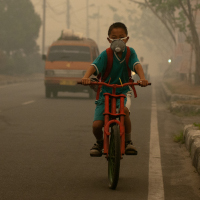
Saving Millions From Deadly Air
View the page for this story
The World Health Organization is urging nations to adopt new air quality guidelines that could save seven million lives a year worldwide. In terms of the numbers of people affected, WHO says fine particulates known as PM2.5 are the deadliest of six types of pollution that need tighter restrictions. Much PM2.5 pollution comes from fossil fuel combustion, so reducing PM2.5 emissions would also benefit the climate. Host Steve Curwood is joined by Dr. Aaron Bernstein, pediatrician and interim director of the Center for Climate, Health and the Global Environment at Harvard University’s T. H. Chan School of Public Health. (09:51)
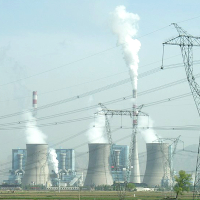
Beyond the Headlines
/ Peter DykstraView the page for this story
Environmental Health News Editor Peter Dykstra joins Host Steve Curwood to talk about China’s plans to quit financing coal-fired power plants in other countries. Also, along the U.S. East Coast, sea level rise is creating “ghost forests” of trees killed by saltwater. In the history calendar, they look back to the 1957 Mayak nuclear disaster in the Soviet Union. (04:29)
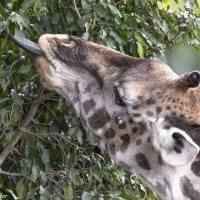
The Agreement: Maasai Giraffe in the Highlands of Kenya
/ Mark Seth LenderView the page for this story
Healthy ecosystems tend to seek balance and in the highlands of Kenya, this dynamic plays out in a tacit agreement between giraffe and their leafy diet. Living on Earth’s Explorer in Residence Mark Seth Lender brings us this commentary. (03:45)
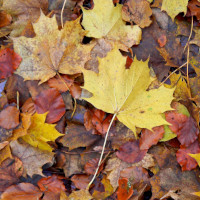
Fall Gardening Tips
View the page for this story
For gardeners in the cooler parts of the Northern hemisphere, now is the time to take stock of this year’s successes and failures. Michael Weishan, a master gardener and Living on Earth regular, joins Host Bobby Bascomb to talk about what worked and what didn’t in his garden this year and what gardeners can do to build fertile soil for next spring. (11:57)
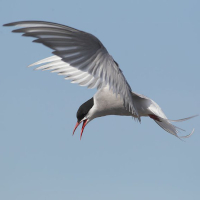
BirdNote®: Migration – Long, Short, And In-Between
/ Mary McCannView the page for this story
The fall harvest season is upon us and for birds that means it’s time to migrate. BirdNote®’s Mary McCann has more. (01:55)

Putting Food By for a Sustainable Harvest
View the page for this story
About 30-40% of the food produced in the United States is wasted, even as tens of millions of Americans are food insecure. As the harvest season picks up, Marisa McClellan, a food writer and author of the book Food in Jars, joins Host Bobby Bascomb to discuss preservation tips and tricks for keeping the bounty and preventing fresh produce from ending up in landfills. (15:12)
Show Credits and Funders
Show Transcript
211001 Transcript
HOSTS: Bobby Bascomb, Steve Curwood
GUESTS: Aaron Bernstein, Mary McCann, Marisa McClellan, Michael Weishan
REPORTERS: Peter Dykstra, Mark Seth Lender
[THEME]
CURWOOD: From PRX – this is Living On Earth.
[THEME]
CURWOOD: I’m Steve Curwood.
BASCOMB: And I’m Bobby Bascomb
Millions of early deaths will be avoided if countries adopt the strict new air quality standards of the World Health Organization
BERNSTEIN: So many people were living in polluted air that was, you know, in excess of what the World Health Organization said was safe previously, and so ratcheting the level down, you know, we could save a lot of lives here.
CURWOOD: Also, It’s harvest time and you don’t need a garden to store up the bounty!
McCLELLAN: I live on the 20th floor of a high rise but sometimes it's actually easier to be a canner who doesn't garden because it means that I have all my time for food preservation and can really work with my local farmers and growers and get the best of what they grew, support them in their work and I feel like everybody wins.
CURWOOD: That and more this week on Living on Earth – Stick Around!
[NEWSBREAK MUSIC: Boards Of Canada “Zoetrope” from “In A Beautiful Place Out In The Country” (Warp Records 2000)]
[THEME]
Saving Millions From Deadly Air
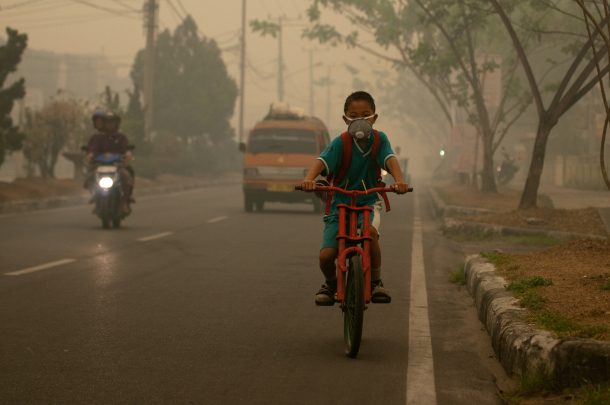
A student cycling to school wears a mask to protect himself from smoke in the city of Palangka Raya in Indonesia. (Photo: Aulia Erlangga, CIFOR, Flickr, CC BY-NC-ND 2.0)
BASCOMB: From PRX and the Jennifer and Ted Stanley Studios at the University of Massachusetts Boston, this is Living on Earth. I’m Bobby Bascomb
CURWOOD: And I’m Steve Curwood.
The World Health Organization is calling for sharp reductions in air pollutants that kill seven million or more worldwide every year, including some 300,000 people in the US alone. On September 22 WHO adopted new and stricter guidelines for six different poisons that commonly pollute the air. These include carbon monoxide, sulfur and nitrogen oxides, low level ozone commonly found in smog, and medium and fine particulates. And it is those fine particulates known as PM two point five that lead to the bulk of early deaths, as these tiny but deadly toxins get sucked in through the lungs straight to the bloodstream where they circulate, just like oxygen molecules. And in the United States the allowable amount of yearly exposure to fine particulates is more than twice what WHO now recommends for all nations. We turn now to Pediatrician Aaron Bernstein, who is the interim director of the Center for Climate, Health and the Global Environment at Harvard University. Dr. Bernstein, welcome back to Living on Earth!
BERNSTEIN: Great to be with you, Steve,
CURWOOD: What are these new standards, and how do they match up to the former standards from the World Health Organization?
BERNSTEIN: So these new standards deal with a lot of the baddies in the air pollution world, the things we know that can be air pollutants that are really bad for our health, and they haven't been updated in a good long while. So one might argue that they're due for some revisions. And they're dramatic in many cases. So particulate matter air pollution, which is the pollutant that we see causing the most harm around the world, it gets defined by its size. So how big the particle in the air is determines essentially how bad it's going to be for our health. And the smaller particles are about two and a half microns in diameter, that's about 1/20 of the width of a human hair. And they've halved the safe level for the yearly exposure. They look at the levels in the air over the course of a year, and they also have a standard for a single day, so it used to be that the WHO said, if you had 10 micrograms per meter cubed of particulate matter, two and a half micrograms in diameter, you were okay. And now they're saying five. That's a pretty drastic reduction.
CURWOOD: So in terms of PM 2.5, talk to me about the implications of that, and just how many lives would be saved if that standard were, in fact adopted universally?

Air pollution is tied to a number of major health concerns including stroke, heart disease, mental health and lung diseases such as cancer, pneumonia, and asthma. (Photo: Nenad Stojkovic, Flickr, CC BY 2.0)
BERNSTEIN: Yeah, so we know that particulate matter pollution is responsible for millions of deaths around the world every year. And, you know, estimates vary, but a recent publication looked at just the particulate matter from fossil fuels, which, of course, is probably one of the bigger sources, if not the biggest source, depending on where you live. And it's estimated about 8 million people are dying from burning fossil fuels that produce particulate air pollution every year, that's one in five deaths. So we know that particulate pollution, particularly PM 2.5, is a big deal for death. And, of course, a host of other health problems, asthma, chronic lung diseases, heart disease, stroke, even lung cancer, and I could go on
CURWOOD: Now, some of the press material from the World Health Organization suggested that perhaps 80% of the deaths now from fine particulates would go away, if in fact, these standards are adopted universally. How does that strike you, Dr. Bernstein?
BERNSTEIN: Well, I think it's not implausible. I mean, we have for a long time underestimated how many people's lives were being lost from air pollution. And we know that so many people were living in polluted air, that was, you know, an excess of what the World Health Organization said, was safe, previously, and so ratcheting the level down, you know, we could save a lot of lives here. And the good news, of course, is that most of that air pollution in many parts of the world is coming from burning fossil fuels. And that means we have an opportunity to not only prevent those deaths today, but also help address climate change.
CURWOOD: So, talk to me about PM 2.5 and how that is related to, say, COVID mortality.
BERNSTEIN: Yeah, so this is a really important connection, Steve, and it actually goes beyond COVID. But there's now very clear evidence that people who've had to breathe more of this particulate matter air pollution, you know, over many years, are more likely to die from a COVID infection. In the United States, colleagues of mine at the Harvard Chan School found that people who had breathe just one microgram per meter cube more for many years, and remember the standard from the WHO was set down from 10 to five, in the United States, many communities will, you know, be in the five to 10 range. So one microgram is not a huge difference. But a one microgram per meter cubed increase in your many-year exposure to air pollution could increase your chance of dying from COVID by 6% or 8% in the United States. And the key part here to me is it's not just COVID. That same particulate matter, air pollution is going to increase your chance of dying from the seasonal flu, or from pneumonias or other respiratory infections. This has been known for a long time. And so it wasn't surprising to many of us to see that it was in true in fact, with COVID, which for many people is a problem for the lungs. So air pollution, and particularly particulate matter air pollution is a critical part of our health, outside of its direct effects on your chances of dying, you know, it could affect you know, how sick you get from a respiratory infection, it can affect our mental health, it can affect brain diseases. And so you know, you really get a lot of health benefits when you reduce exposures.
Every year, exposure to #AirPollution is estimated to cause 7⃣ million premature deaths and result in the loss of millions more healthy years of life.
— World Health Organization (WHO) (@WHO) September 22, 2021
???? guidelines recommend air quality levels to protect health and save lives around the ????????????
???? https://t.co/7NnUI54JzT pic.twitter.com/C3CaWnVChf
CURWOOD: So to what extent do the current air quality standards in the US match up with the new standards that the World Health Organization says we should adopt?
BERNSTEIN: It's a good question. It's kind of a mix and match. In some cases, the WHO standards are a little more stringent and in some instances they're less stringent. You know, for the particulate matter annual average, the WHO set a standard of five, and in the United States, we have an annual standard of 12. For ozone, we have a standard in the United States of 70 parts per billion. In the WHO standard, they have 60 parts per million. So, you know, for many of these pollutants and again for particulate matter, the evidence suggests that there's no safe level exposure. And so it really becomes a question of trade offs, which is how much can we reduce for how much money is it going to cost? And, you know, what's interesting is that, particularly in countries that have cleaned up a lot of air pollution, like the United States, even when you've done that, we still see when you look at the health effects and include the health effects and the costs of the harms the air pollution in your cost benefit, turns out that, you know, reductions below current levels are cost effective, that we actually would save money. The challenge is that when policymakers make rules, they're very quick to look at the cost of cleaning up the air, the benefits often are curtailed for a variety of reasons. And so we don't necessarily lower the pollutant levels to where the science would say. Now, we're never going to obviously get to zero in terms of particulate matter, because even if he got off fossil fuels, there'd still be things burning, there'd be secondary particles from other sources, even natural sources. But there's no question that there are many places, even the United States where particulate matter air pollution is a problem. And I should note that in the United States, you know, everyone has had better air quality over the last 40 years, the benefits have not been shared equally. So it turns out that white Americans have gotten improvements in their air quality more than Black Americans and Latinx Americans. And there's one part of the country and it is the only part that has seen a trend in the wrong direction. And that's in the northwest, where wildfire smoke has actually been so prevalent that the exposure particles has actually gone up.
CURWOOD: But wait, Dr. Bernstein, you're saying that the WHO level of five for fine particulates compares to 12 as the official US limit? Sounds like the US needs to think again about the particulate levels.
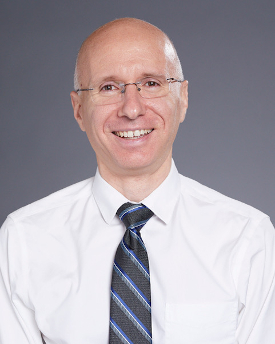
Aaron Bernstein MD is the Interim Director of the Center for Climate, Health, and the Global Environment at the Harvard T.H. Chan School of Public Health, a pediatrician at Boston Children's Hospital, and an Assistant Professor of Pediatrics at Harvard Medical School. (Photo: Courtesy of Harvard T H Chan School for Public Health)
BERNSTEIN: Yeah, well, the science would certainly suggest that there are harms happening at levels below the current air quality standard. And, you know, the Clean Air Act in United States directs EPA to review the science and to set standards that are protective of health, including for vulnerable populations. And so we can expect that EPA is likely to lower the exposure standard for particulate matter, there was an effort already for many years now to lower the ozone standard as well. And there's a real political melee that happens, because, you know, polluters don't want to stop polluting so much, even if the pollution is causing pretty big harms. And again, there's a huge equity issue here, you know, it is in an era where we're all so focused on addressing, you know, systematic discrimination, it's hard to look at the data that makes so clear that if you're a Black American or Latinx American, not only are you exposed to way more of this pollution, because of where you live, and where those places are in relation to power plants and roads, you're the least responsible for producing it. And so it's this sort of double inequity. And so on the flip side of that, the more we can do to reduce pollution emissions, the more will see reversal of historical injustices. And so I'm cautiously optimistic that the more we shine light on these inequities, the toll that pollution from burning fossil fuels is having, the more political will we’ll see to get it even cleaner than it is.
CURWOOD: Aaron Bernstein is the interim director of the Center for Climate Health and the Global Environment at the Harvard T.H. Chan School of Public Health and a pediatrician at Boston Children's Hospital. Ari, thanks so much for taking the time with us today.
BERNSTEIN: Thanks for having me, Steve.
Related links:
- Read more from the WHO about their new air quality standards
- Harvard University: 8 million deaths from fossil fuels
- The Guardian | “WHO Slashes Guideline Limits On Air Pollution From Fossil Fuels”
- About Aaron Bernstein, M.D.
[MUSIC: The 442s, “The Multitude” on The 442s, by Adam Maness in collaboration with The 442s, self-published]
Beyond the Headlines

A coal-fired power plant in Shuozhou, Shanxi, China. (Photo: Kleineolive, Wikimedia Commons, CC BY 3.0)
CURWOOD: It's time now to take a look beyond the headlines with Peter Dykstra. He's an editor with Environmental Health News, that's EHN.org and DailyClimate.org. He's on the line now from Atlanta, Georgia. Hi there, Peter, how are you doing? What have you got for us today?
DYKSTRA: Well, hi, Steve. There's a story coming out in advance of the climate summit happening in little over a month in Scotland starting October 31, where China has told the world that it's going to quit financing coal fired power plants in other countries.
CURWOOD: Well, that's pretty good news. I mean, China has been exporting a lot of coal fired power plants. But on the other hand, they have like over 900 themselves, doesn't sound like they're gonna shut those down, or stop building those at home.
DYKSTRA: Now, China has four times as many coal burning power plants as the next leading nation, which is, of course, the United States. We're talking about the financing of a dozen coal plants in South Africa, other nations in Southeast Asia, Pakistan, South America, I don't think anyone is regarding it as a huge turnaround by China, still the world's largest emitter, with the US and India not too far behind.
CURWOOD: It's nice, though, to see China put something down on the table because before Paris, the US and China got together and really hammered out a lot of the details of a deal, but right now the US and China don't seem to be getting on and seem to be in any kind of mood to develop an agreed upon climate plan. So this could be good news.
DYKSTRA: That's right, but it's past time for us to quit playing two steps forward and one step back on climate.
CURWOOD: Indeed. Hey, what else do you have for us today?
DYKSTRA: Here's a term that will give you the creeps a little bit. And it's happening along the US East Coast, among other places, the phenomenon of ghost forests. These are coastal wetlands, forests, trees, like cedar trees that are dying off as saltwater intrusion reaches into freshwater wetlands and kills the trees, turning them from verdant green, to stark white.
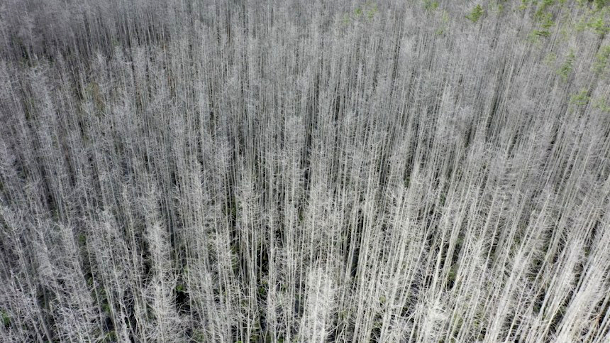
Sea level rise linked to climate change is creating "ghost forests" up and down the U.S. East Coast and elsewhere. (Photo: New Jersey Parks and Forestry, Public Domain)
CURWOOD: And I gather some of these have been seen in your old home state, New Jersey.
DYKSTRA: That's right. Jersey, with all the wetlands and the pine barrens is an unfortunate leader in this environmental setback, but it's happening up and down the coast. And saltwater intrusion isn't just a factor in killing off coastal forests. It's a factor in potentially killing off coastal water supplies. Here in the southeast, along the Georgia sea coast and South Carolina around Jacksonville, Florida, a lot of the drinking water sources are freshwater aquifers along the coast. As saltwater literally gets sucked in and pushed inward by sea level rise, it's going to contaminate those aquifers, putting them out of reach, just as populations along the coast continue to grow.
CURWOOD: That is not good news, Peter. Well, let's look back in history now for a moment. What do you see?
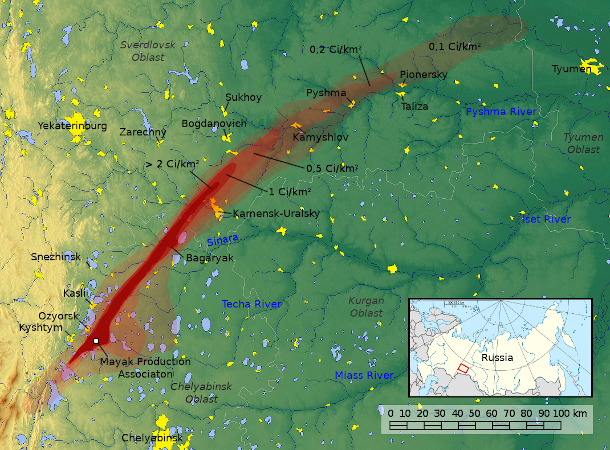
Track of the Eastern Ural Radioactive Trace, the area contaminated by the 1957 Mayak disaster. (Photo: Goran tek-en, Wikimedia Commons, CC BY-SA 4.0)
DYKSTRA: On September 29, 1957, a tank with liquid nuclear waste exploded at a plant called Mayak in the central Soviet Union, hundreds of square miles down wind were contaminated by radiation. Because of the secrecy in the Soviet Union, we don't know how many people were affected or killed. But it's regarded as the third worst nuclear accident in history in terms of an area and population contaminated, behind only Chernobyl and the Fukushima accident in Japan.
CURWOOD: And I remember hearing something about Chelyabinsk. This is the same place, yes, no?
DYKSTRA: It's the same place. So good were the Soviets at keeping secrets about their nuclear work that Chelyabinsk was actually a huge, teeming nuclear city that no one knew about. It was deeply contaminated. And again, we still don't know quite how much, how fully or whether it's still contaminated. But what became known as the Chelyabinsk accident was one of the worst ones we've ever had.
CURWOOD: Let's hope that those kinds of accidents stay in the history books, Peter. Peter Dykstra is an editor with Environmental Health News. That's EHN.org and DailyClimate.org. Thanks so much. We'll talk to you again real soon.
DYKSTRA: All right, Steve, thanks a lot. Talk to you soon.
CURWOOD: And there's more on these stories that the Living on Earth website that's LOE.org.
Related links:
- DW | “Climate Change: China To Exit Coal-Fired Power Abroad”
- NBC | “Ghost Forests Creep Up U.S. East Coast”
- Learn more about the 1957 Mayak nuclear accident near Chelyabinsk, Russia
[MUSIC: Olga Egorova, traditional Russian- Ukranian Medley, on David Benedict’s Mandolin Mondays #157]
BASCOMB: Coming up – Fall gardening tips from our gardening guru. That’s just ahead on Living on Earth.
ANNOUNCER: Support for Living on Earth comes from Sailors for the Sea and Oceana. Helping boaters race clean, sail green and protect the seas they love. More information @sailorsforthesea.org.
[CUTAWAY MUSIC: Berklee George W. Russell Jr. Quartet (George W. Russell https://www.instagram.com/georgewrusselljr, Walter Smith III https://www.instagram.com/wsmiththree, Danny "Mo" Morris https://www.instagram.com/dmoplaysbass, Sean Skeete https://www.instagram.com/sean.skeete), “Song for DJ Henry,” by George W. Russell Jr., independent recording by Berklee College of Music (https://www.youtube.com/watch?v=iFf85PVKM0w) which holds all of the rights.]
The Agreement: Maasai Giraffe in the Highlands of Kenya
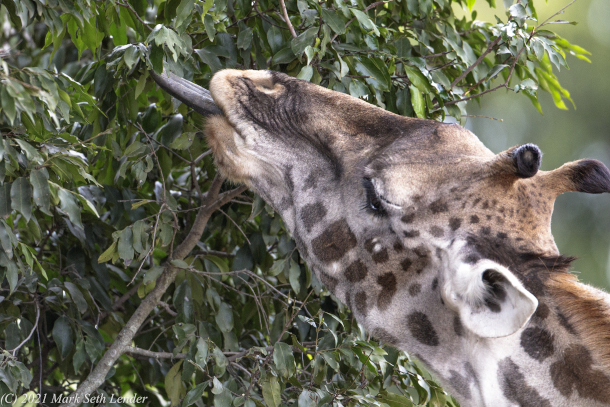
A giraffe extends her long “blackberry-ice-cream tongue” to grasp commiphora leaves. (Photo: © Mark Seth Lender)
CURWOOD: It’s Living on Earth, I’m Steve Curwood.
BASCOMB: And I’m Bobby Bascomb
Healthy ecosystems always seek balance and, in general, any creature that doesn’t comply won’t last long. Living on Earth’s Explorer in Residence, Mark Seth Lender, has this example of a tacit agreement for survival between species in the highlands of Kenya.
The Agreement
Maasai Giraffe
Laikipia Plateau
LENDER: At a grove of commiphora trees giraffe are grazing. They will eat acacia also but the commiphora have no thorns. They reach their necks into the rooftop of the grove. The day is cool and light.
Lean and languid, giraffe move about. Their movements are softness, the patination of their skin, concentric watery shapes like ripples in daubed paint white to light ochre to a center of raw umber, as tempting to the eye is puddles to a child. They are vibrant and alive and as apparent as a forest. Even behind a specter of branches, tangled and dark, they cannot pretend to hide.
But at a distance, at the edge of the woods passing through sun and shade it is impossible to tell, if the herd is in among the trees or in front. How far is also confusing. And with their long legs and long stride, how fast.
Exactly the things a predator watching needs to know.
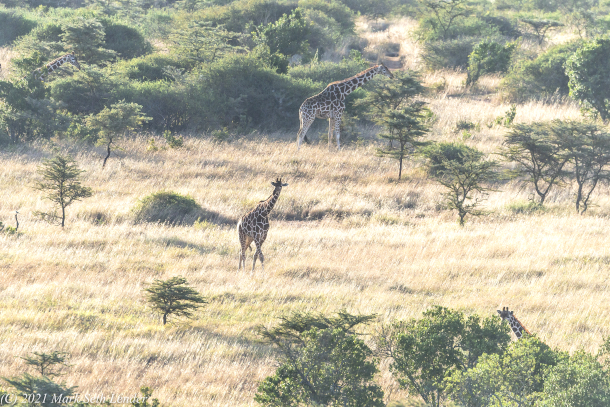
Giraffe herd grazing on commiphora (Photo: © Mark Seth Lender)
And not knowing, more often than not, will leave them alone.
A giraffe extends her blackberry-ice-cream tongue as dexterous as index and thumb. It wraps around a stem high in the crown. The leaves rustle. She draws them into her wrinkled mouth. Her face furred and furrowed she is not young and the leaves are sweet to her.
And yet she will not stay. She will not eat only of this one tree nor continue in this single place. None of them will, not long enough to nourish much less to staunch their hunger.
Because, tree and giraffe hold an agreement: Do not harm me.
The tree bitten to the quick will make itself bitter as bile. And send a warning through the air, an invisible semaphore too thin to be detected except by other trees, downwind, who will sense and heed the warning; and then they too will make themselves impossible to eat. So, giraffe refrain though the leaves of the grove are plump and green and good. Which makes for a movable feast and for the tree means not being brought to grief but only a pruning. Perhaps this is what the tree needs for the sake of the thick new growth that will come. Or if not needs, at least endures at no great price.
And so each kind, giraffe and tree, can and will, continue.
BASCOMB: That’s Living on Earth’s Explorer in Residence, Mark Seth Lender.
Related links:
- Read the Field Note for this essay
- Mark Seth Lender’s website
- Special thanks to Destination: Wildlife
[MUSIC: Ayub Ogada, “Kothbiro” on En Mana Kuoyo, traditional Kenyan/arranged Ayub Ogada, Real Words Records]
CURWOOD: The next meeting of the Living on Earth book club is coming up on October 5th at 8:00 pm eastern. We’ll be talking with Kinari Webb about her book Guardian of the Trees, a memoir about her time as a medical doctor in Borneo. Her life’s work there is to save the rainforest by healing the people. It’s sure to be a great chat. You can register for this free event at loe.org/events. That’s loe.org/events. And if you like, email a question in advance for Dr. Webb to loebookclub@loe.org. That’s loebookclub@loe.org. See you there!
[MUSIC: Ayub Ogada, “Kothbiro” on En Mana Kuoyo, traditional Kenyan/arranged Ayub Ogada, Real Words Records]
Fall Gardening Tips
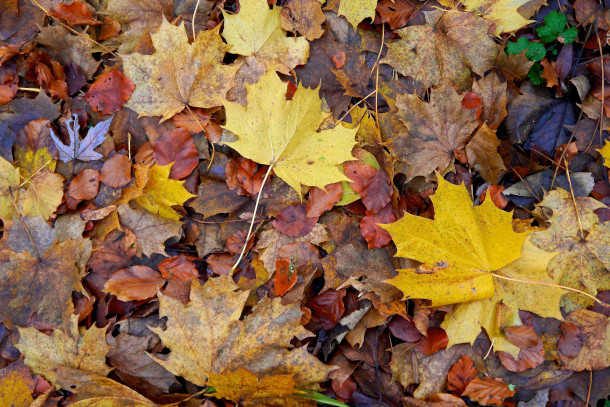
Leaves are loaded with trace minerals that trees absorb from the soil and when used in the garden they can feed earthworms and good microbes. (Photo: Hywel Jones, Flickr, CC BY-NC-ND 2.0)
CURWOOD: So, Bobby, September 20th was the harvest moon.
BASCOMB: It was. Yeah….
CURWOOD: I managed to get a few tomatoes out of my little garden bed, especially the sun sugars cherry tomatoes Michael Weishan suggested in the spring, but I know you actually have a pretty big garden at your place. How did it go this year?
BASCOMB: Well, you know we had a bumper crop of kale this year as every year. Everyone who came to my house actually had to go home with an arm load of kale. But the broccoli was kind of a bust and so was the cabbage.
CURWOOD: Ahh… better luck next year.
BASCOMB: Yes! But you know, Steve, gardening season never really ends. This is a fine time around here to plant a last crop of cold hardy plants like lettuce. You can get garlic in the ground pretty soon and a lot of perennial flower bulbs are actually planted in the fall. And so for some more fall gardening tips let’s bring back Michael Weishan. He’s our gardening guru and former host of the Victory Garden on PBS. Michael, welcome back to Living on Earth!
WEISHAN: It is a delight to be back as always.
BASCOMB: Oh, it's always so fun to have you. So how did your garden grow this summer?
WEISHAN: Oh, well, I would honestly say this has been the most miserable gardening year I've had in the last 20.
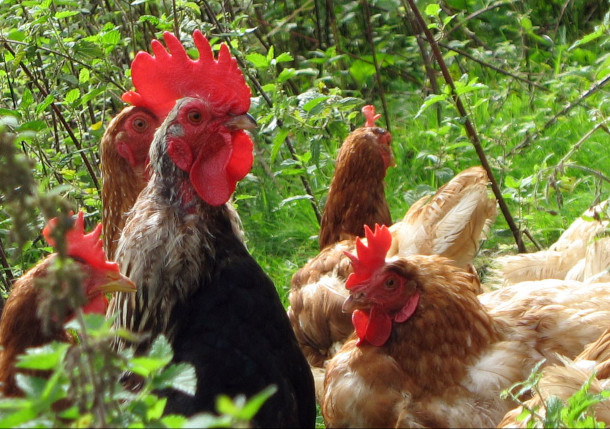
Chickens love to eat almost everything and are great for breaking down leaves. (Photo: Jen Zajac, Flickr, CC BY 2.0)
BASCOMB: Wow.
WEISHAN: Our weather has been terrible here in New England, brutally hot summers and very rainy with feet literally rain. So any problem that you could imagine that would come out with lots of rain and humidity did. Slugs all over the place, every type of fungal mildew, downy mildew kind of problem insects galore. But you know, you take your successes where you get them, right. I grew celeriac this year, which failed last year. And this year I have huge, you know, softball sized bowls of celeriac to store for the winter. Which, if you don't know what that is, it's a wonderful vegetable. It's a bulbous vegetable relative of the carrot family, parsley family that forms this large naughty-like ball that has the flavor of celery. So you don't have to buy celery then in the winter you can store this because it stores like a potato. And they're just delicious in soups and stews and other things where you would normally put celery and it holds up a little better because it has an evolved like you know squash like consistency.
BASCOMB: Yeah, I've had them from CSA shares in the past I've never tried growing them though. But I know they're nice said just chop up and roast in the in the oven like a root vegetable.
WEISHAN: Exactly. And you know, they're really interesting plants, you can eat the greens, which look like celery, and tastes like celery, very strong celery, but they're very handsome plant. I was very excited. So that did well. I'll tell you, you know, and share with our listeners. Even the flower border did not do well this year. I mean, the long perennial border did, but the cut flower garden with all the rain and stuff, I mean the cosmos, it just it's all went down. I'm ready to be done.
BASCOMB: You're ready to be done.
WEISHAN: Yeah Bobby, I'm ready to be done. I'm moving on to 2020 where are we 2022. Now coming up.
BASCOMB: Oh man, you know, I always feel like this is a great time to reflect back on the summer and think about those things that didn't work out so well and things that that worked out better. And you know, I should probably write notes to my future, you know, spring planting self about things like that, you know, things like, don't plant the basil near where the ground cherries always come up and shade the basil and then swear that you'll be better about weeding them out because you won't. Do you have any of those kind of lessons learned this year?
WEISHAN: Well, I think you've stated the lesson learned which is to keep a diary. And if nothing else, just note down things that worked and that didn't. I mean, for instance, I've mentally noted to myself last year that I put the celeriac in a not sunny enough space so I shifted it this year and it did really well. I really think this is the time of year for review and really thinking about, while you can still see it, you know, while it's still there, what worked and what didn't what needs to be moved around. And keep those notes in a viable format, whatever works for you, for next year.
BASCOMB: Well, I know you said you're ready to give up on gardening for the year but are there any plans that maybe listeners should think about focusing on this time of year? I mean, here in New England, we still have weeks or so before frost and in other parts of the country, maybe this is a fine time to plant.
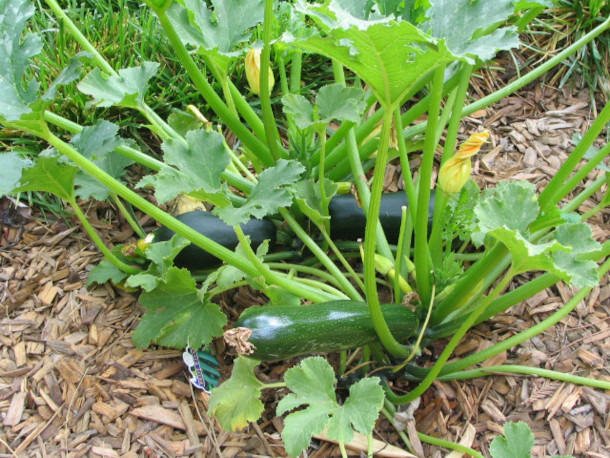
It was a tough year to grow zucchini due to hot and wet weather in the Northeast US (Photo: Thomas Kriese, Flickr, CC BY 2.0)
WEISHAN: So with that in mind, there's still time for lettuces and other crops here. Pretty much now it's a harvesting question in New England. But if you're in the south, or if you're in the West, this is the beginning of the gardening season, at least the cool weather gardening season. So all the cool weather crops that we would be planting normally in the spring, they start now because this is their more temperate time as opposed to being baked, which has been the case. So you know, it's been a tough year. And I think that's something that we need to think about the adaptability of, you know, our plans and how rigid we are in changing things around and adapting more. For instance, the growing seasons are shifting, there's no doubt about that. And the climate zones are shifting North so it's getting warmer. We here had historically been in 5B but I was just reading the American Horticultural Society thinks we're now in 6B, you know we're up a zone almost since 1970. And another 20 years would put us into 7. That's a huge shift, there's a whole border line between five and six and seven of plants you can grow and not grow. And as you shift further south, you knock out the cold weather crops, things that do very well and only cool temperatures. So you know, I think there has to be a realization that we need to change what we're doing. It's Mother Nature you gotta move with her because we move against her she's gonna whack you down like a mole.
BASCOMB: [LAUGH] Yes, there's certainly no use in fighting Mother Nature, you just have to roll with it as you said. I guess here in New England though, I mean a longer growing season kind of sounds attractive. I mean, if you have to find a silver lining to all of the horrible things associated with climate change, at least we get another month or so out of our growing season.
WEISHAN: Yeah that's true so I mean you know, things like we were talking about like the leeks and the celeriac and other really long season crops that we wouldn't have time for sometimes like and big huge pumpkins and things if the start of the season is earlier then you can plant this stuff much earlier and move all the way through everything has a silver lining to it so it's not doom and gloom right? But there are changes that we need to make as you know gardening folks to adapt to the new reality.
BASCOMB: Well, you mentioned earlier that many many challenges that you've had and I think we've all had this year with gardening and one of them that I really struggle with is pests. I actually only harvested one zucchini this year. Usually I'm you know, leaving them on neighbor's porches you know, neck deep and zucchini bread by now but the squash vine borers were just horrible. Is there anything gardeners can do now in the fall to maybe mitigate next year's pests?
WEISHAN: Well, you beat me by one because I had no zucchini.
BASCOMB: Oh, really? Oh, gosh, that makes me feel slightly better. I'm sorry for you.
WEISHAN: Yeah, the plants disappeared. I mean, how can you lose zucchini? That was a factor of the extra warmth. so the moths, the borer moths that lay the eggs were around a lot longer than they normally were. So you know that if you use row cover over the squash, when the moths are active, then they don't have time to lay their eggs and so you'd then uncover them and generally you're good to go. But this year, I thought it was late enough I planted them out and they were all destroyed.
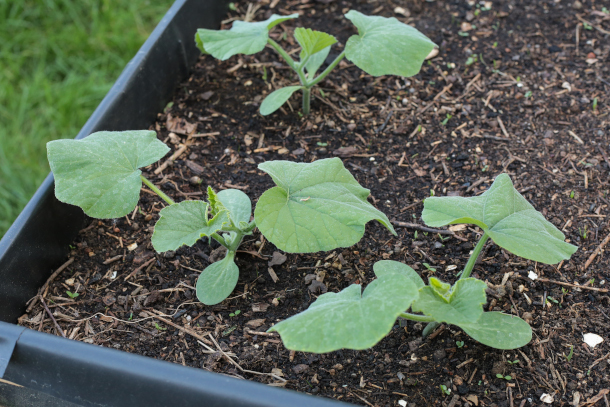
Small leaves sprouting in a garden bed (Photo: Maja Dumat, Flickr, CC BY 2.0)
BASCOMB: Wow.
WEISHAN: So you know, there's things that you do now, not in terms so much of insect pests, but in terms of disease, for instance, tomatoes with late blight, those vines should be removed and not composted they should be disposed of or burned. So you know, soil you know, again, this is really the time to think about soil and we do it now south of here we'll be doing it in a month or twos time before Christmas in general. There are many things you can do in the fall in terms of soil improvement, whether it's cover crops or other type of enhancements. We've done cover crops, winter rye, is one of the most common. Although I was reading about these giant radishes have you had these radishes as a cover crop?
BASCOMB: No.
WEISHAN: That they grow very quickly in a very deep, long roots and then they die and rot and essentially form these cavities in the soil so that in the spring, they've sort of aerated your soil without tilling.
BASCOMB: I like the idea.
WEISHAN: A friend of mine told me about that, I have took a look into that because that is sort of a that's a revolutionary kind of concept to me. I use leaves for soil improvement because you have a billion of them and what are you going to do with them you have to get them to go somewhere. So what I do is I collect them in tarps and then layer them on to the beds and let them sit for the winter and if they're wet, they form a mat and they don't blow around and in the spring, then very early on I get out there till them in and break them up. Now they won't be fully composted, but once they're chopped within about three or four weeks, they decay very quickly so then I rototill them again. And that improves what's called the tilth of the soil which is the ability to absorb moisture and air in particular oxygen into the roots. So it gives you that fine crumbly soil it's minimally also nutritional you know the other way to get rid of the leaves is with chickens. Did I ever tell you this story?
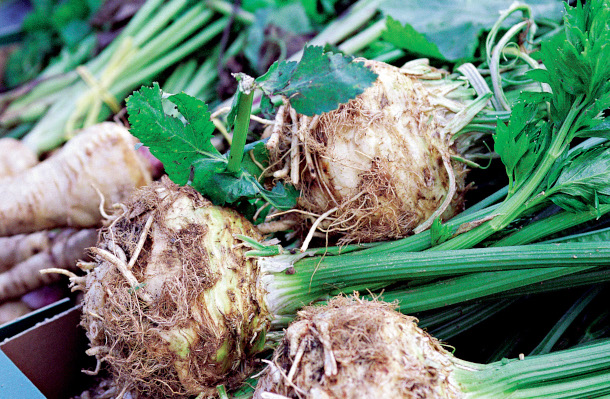
Celeriac is a bulbous plant with a similar taste to celery (Photo: Skanska Matupplevelser, Flickr, CC BY-ND 2.0)
BASCOMB: I don't think so.
WEISHAN: So you can actually, the chickens scratch in order to forage and if you put all the leaves in the chicken coop area, they will scratch them into the ground and by spring they will be totally gone. And I'm talking huge like two foot tall piles of leaves the chickens get into the into the piles and they're like scratch, scratch, scratch, scratch, scratch and there's like leaves flying up all over it, you know it's just the craziest thing to see. And essentially they do with the rototiller does in the spring right? It just eliminates them entirely. So if I have too many of these I don't know what to do with, rather than hauling them to the town composting area I just give them to the chickens, so.
BASCOMB: Yeah, you and I both have chickens and I love this idea of a chicken tractor they sometimes call it you know, the idea of being just let the chickens into the garden when you're done growing everything because otherwise they'll you know, peck holes and every tomato you have. But you let them into the garden, they eat the grubs and snails and all these little things that are going to cause you problems, scratch up the soil, maybe leave some fertilizer behind. Do you ever do that sort of thing?
WEISHAN: I am too lazy to roll a giant chicken caravan around my property. I use ducks for that purpose because, you know again, as we were talking about the chickens love to scratch but the ducks because they trill the soil as opposed to scratch it they trill it with their beaks. So they search for worms and other things underneath that way. They do very well eating grubs. They love slugs, and earthworms which I'm not so excited about them eating but any type of bug moving ticks. They're also big consumer of ticks and so I have ducks and geese for that purpose. They keep the algae on the pond down in the summer and then In the fall in the spring I let them wander around the beds and especially in the orchards they eat all the falls too, which is great.
BASCOMB: Do you do anything with the waste from your chickens and your ducks in terms of you know, composting their manure for fertilizer or anything like that?
WEISHAN: Oh, yeah, yeah. When it's cleaned out, it all goes in the compost pile and it's mixed in with the garden waste and all this stuff and it produces an incredible compost. And I have three huge compost bins that are just fantastic for producing large quantities of compost, which I then use mostly as potting soil.
BASCOMB: Yeah, exactly. And I have to say, you know, talking with you a master gardener who knows everything there is to know about gardening makes me feel a lot better about my own gardening failures this summer. You know, my one sad zucchini and shriveled up cabbage, they don't seem so bad. Michael Weishan is a master gardener. He's been host of the Victory Garden on PBS and a regular garden help here on Living on Earth. Michael, thanks again for taking this time with me today, it's always so much fun to chat with you.
WEISHAN: Absolutely. Absolutely Bobby, thank you so much.
Related links:
- Learn more about Michael Weishan’s World of Gardening
- Listen to Living on Earth’s conversation with Michael Weishan about 2020 Fall Gardening Tips
[MUSIC: Paul Rishell & Annie Raines, “Blues For Tampa Red” on I Want To Know You, by Rishell/Raines, Tone-Cool Records]
CURWOOD: Coming up – Tomatoes, and pumpkins and kale, oh my! From home gardens to farmer’s markets, we’ll have some tips for preserving the bounty of the harvest season. That’s just ahead on Living on Earth.
ANNOUNCER: Funding for Living on Earth comes from you, our listeners, and United Technologies, combining passion for science with engineering to create solutions designed for sustainability in aerospace, building industries, and food refrigeration.
[CUTAWAY MUSIC: Eric Tingstad, “South to Carolina” on Electric Spirit, by Eric Tingstad, Cheshire Records]
BirdNote®: Migration – Long, Short, And In-Between
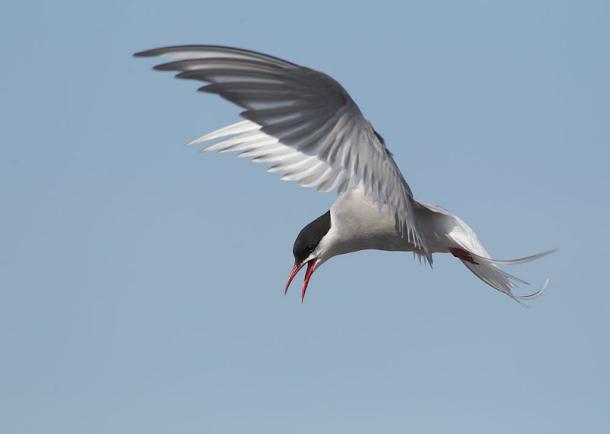
Arctic Terns migrate pole-to-pole each year, traveling up to 44,000 miles! (Photo: Tom Grey)
BASCOMB: It’s Living on Earth, I’m Bobby Bascomb.
CURWOOD: And I’m Steve Curwood
The fall harvest season is upon us and for birds that means it’s time to migrate. Birdnote’s Mary McCann has more.
BirdNote®
Migration - Long, Short, and In-Between
Written by Bob Sundstrom
MCCANN: In September, Arctic Terns fly south over the ocean, from Alaska all the way to Antarctica. [Arctic Terns’ gruff calls] Also in September, the last Rufous Hummingbirds depart their breeding range in the West, following “floral highways” of mountain wildflowers south to Mexico. [Male Rufous Hummingbird wing-whistle] Ruby-crowned Kinglets are leaving the northern evergreen forests where they nest, on their way to milder climates. [Ruby-crowned Kinglet song] Each of these birds is migrating, but on a very different course. All have the same adaptive goal — making the most of food and breeding opportunities that change with the seasons. Arctic terns follow one of the longest annual migrations, traveling as much as 44,000 miles each year. Arctic tundra provides their ideal nesting site in summer, the Antarctic, the ideal feeding grounds in our winter.
[Arctic Terns’ gruff calls]
Rufous Hummingbirds are medium-range migrants, traversing about 5,000 miles a year between temperate and tropical nectar sources.
[Male Rufous Hummingbird wing-whistle]
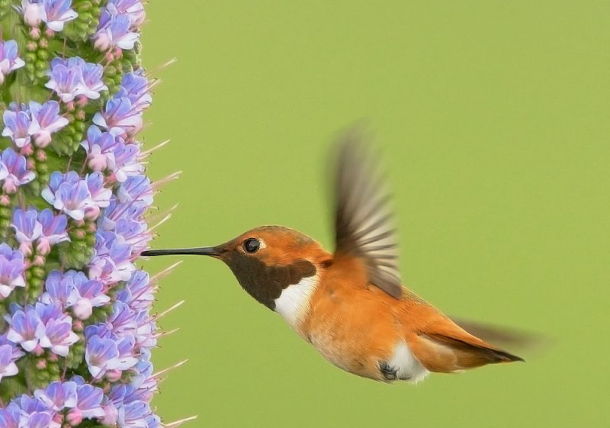
Rufous Hummingbirds are medium-range migrants who travel about 5,000 miles a year between temperate and tropical nectar and small insect food sources. (Photo: Tom Grey)
Some Ruby-crowned Kinglets are altitudinal migrants, especially in the West. They may remain close to the same latitude all year but spend the cold months in the relative earth of the lowlands dining on insects and eggs. In summer, you’ll need to ascend thousands of feet into the western mountain ranges to hear the kinglet’s exuberant song.
[Ruby-crowned Kinglet song]
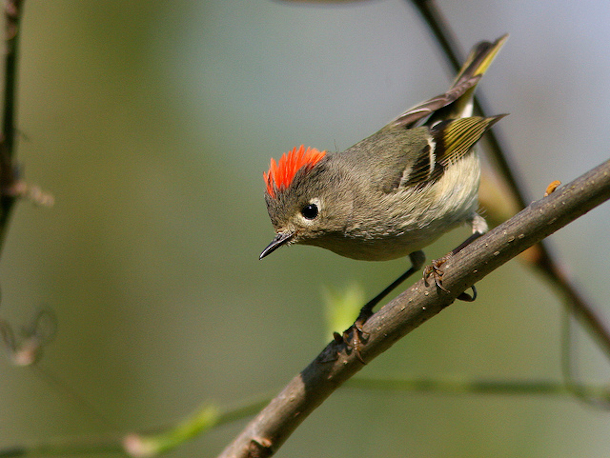
Some Ruby-crowned Kinglets are altitudinal migrants that spend the cold months in the lowlands and move up into the mountains for summer. (Photo: Kenneth Cole Schneider)
###
Bird audio provided by The Macaulay Library at the Cornell Lab of Ornithology, Ithaca, New York. Arctic Tern calls, Ruby-crowned Kinglet song and Rufous Hummingbird call recorded by G.A. Keller.
Ambient songbird track recorded by C Peterson.
BirdNote’s theme music was composed and played by Nancy Rumbel and John Kessler.
Producer: John Kessler
Executive Producer: Chris Peterson
© 2013 Tune In to Nature.org September 2013 / 2017 / 2020 Narrator: Mary McCann
ID# 091307migr3KPLU migration-07b
Arctic Tern statistics from: Berthold, Peter. Bird Migration: A General Survey. New York: Oxford University Press, 1993.
https://www.birdnote.org/listen/shows/migration-long-short-and-between
CURWOOD: For photos migrate on over to the Living on Earth website, loe.org
Related links:
- Find this story and more on the BirdNote® website
- More about Arctic Terns
- More about Rufous Hummingbirds
- More about Ruby-crowned Kinglets
Putting Food By for a Sustainable Harvest

Tomato jam is an all-time favorite recipe from readers of Food in Jars. It’s a sophisticated ketchup substitute that can be used in anything from a cheese platter to a burger. (Photo: Courtesy of Food in Jars)
CURWOOD: So, Bobby before the break you talked with Michael Weishan about your gardening setbacks and successes. It’s the end of the season, so what are you planning to do with all your excess produce?
BASCOMB: Well, I’ve been freezing a lot of tomatoes and we actually made apple cider last week with most of our apples. You know the harvest season, right now, is really a sweet spot when many gardeners and farmer’s market still have summer produce like tomatoes and cucumbers but fall pumpkins and apples are also abundant.
CURWOOD: Right, for my grandmother, like so many of her generation, this was a time to can, pickle, and dry food to get through the long cold days of winter ahead.
BASCOMB: For sure, today, though, we really waste a lot of food in this country. Between 30 and 40 percent of all the food produced in the US is wasted. And that adds up to a huge contribution to greenhouse gas emissions, roughly the equivalent of 32 million cars on the road.
CURWOOD: Oh yeah and yet people still go hungry.
BASCOMB: Right. So, to get some tips on how to avoid some waste and preserve the food of the harvest season I am gonna bring in Marisa McClellan now. She’s a food writer, blogger, and author of the book, Food in Jars. Marisa McClellan, welcome to Living on Earth!
McCLELLAN: Thank you so much, I'm delighted to be here.
BASCOMB: So some of our listeners may be gardeners, but let's say you don't have a garden of your own, what are the best places to get local food this time of year for preserving?
McCLELLAN: Well, some of the very best places to go are your local farmers markets or farm stands. I love to go to the farmers market that happens in my neighborhood once a week. And I've been going there for almost 20 years now. And so I have made lots of friends with my farmers and they like to hook me up with seconds and good deals of produce, so it works out well.

At the start of the fall season tomatoes are abundant in markets so it's the perfect time to preserve sauces, broths and purees. (Photo: Missy, Flickr, CC BY-NC-ND 2.0)
BASCOMB: Oh, do you have to go and you know, glean the apples on the ground at the end of the apple season, that sort of thing.
McCLELLAN: I do that sometimes. But I have gotten to know so many people that I can often just email or text and say- hey, I'm open, you know, whatever you've got in terms of seconds, if you've got 15 or 20 pounds of something you're looking to move, I'm your girl. And they will bring me boxes at the farmers market and we'll do a little behind the table deal and I'll go home with 20 pounds of apples or peaches or pears or whatever you know they have that needs to be used.
BASCOMB: I believe you live in a high rise in a city you're not on a farm in the middle of nowhere and you're still pulling this off.
McCLELLAN: It's true I live on the 20th floor of a high rise in downtown Philadelphia. But you know sometimes it's actually easier to be a caner who doesn't garden because it means that I have all my time for food preservation and can really work with my local farmers and growers and get the best of what they grew, support them in their work and I feel like everybody wins.
BASCOMB: You know, I remember going to my grandmother's house when I was a little kid and she'd have me go down to the basement and get potatoes for dinner. They were stored in this this huge wooden bin, it seemed huge to me at the time anyway, full of sawdust and it was just a simple way to keep potatoes through the winter. Are there other ways to keep fresh food fresh, you know for the long haul?
McCLELLAN: Well, these days that is a certainly a tried-and-true technique of sort of root cellaring things you know, potatoes, carrots, apples, winter squashes all do really well in sort of those cool, slightly moist environments. And then as you move into sort of modern storage methods, you know there's nothing better than a home freezer for some things.
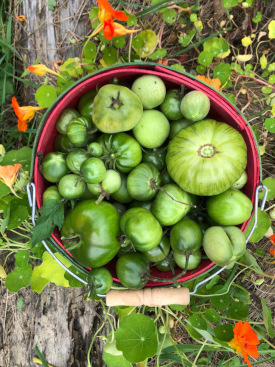
Green tomatoes are often abundant at the end of the summer season in the beginning of fall. A delicious way of preserving them is making green tomato chutney. (Photo: Courtesy of Bobby Bascomb)
BASCOMB: What types of foods do you think freeze really well?
McCLELLAN: I think that things like peaches you know, sliced up maybe mixed in with a little bit of sugar to help prevent freezer burn is a good way to go. You can also do individually quick frozen peaches like you get at the grocery store where you cut them into quarters and lay them out on a cookie sheet and freeze them like that and then funnel them into a plastic bag. I love to freeze pesto because there's no other good way to preserve it but it's such a delicious way to capture all of those herbs that happen in the garden at the end of the season. I've taken to making a plant-based pesto just to ensure that I have something that I could feed to anybody who comes my way so I do it with nutritional yeast and sunflower seeds as opposed to the traditional cheese and pine nuts and so then it's not free and it's dairy free and you know anybody can eat it. Other things that I like to freeze I will often freeze kale when that's in season and the way I do that best practice typically has you blanch your greens, but I find that they keep for several months if you just wash them, pull them off the stems and then cram them into Ziploc bags and freeze those and then what I do is I just pull out a handful of leaves when I want to make a pot of soup or something like that, chop them up or even just crumble them over the pot because it kind of crumbles frozen and then it's so easy and it's a you know, a almost work free way of putting up that kale or those greens.
BASCOMB: Okay, well I'm interested in that one I have always just a bumper crop of kale every year. It comes up on its own I don't even plant it anymore. And I have made kale soup kale fritters, kale chips, kale curry, I mean I think I've exhausted the ways to make kale to be honest with you, but I haven't tried just freezing it something simple as that.
McCLELLAN: It is game changing actually because you know it can be a lot of work to break down kale when it's fresh but when it's frozen, it just kind of breaks down on its own. It really can just kind of crumple it up. And so it's easy to use. I use it in like scrambled eggs skillets soup, pasta sauces, it's great.
BASCOMB: All right, I'm gonna give it a try. Now of course apples are in season right now. What are your favorite things to do with apples to preserve them?
McCLELLAN: There's nothing better than just plain old homemade applesauce. You can can it, you can freeze it. I also love to make apple butter and I do that in a slow cooker where I'll just keep in apples that have been cored and peeled, add a little water, cook them down until they're soft, zap it with an immersion blender right in the slow cooker and then continue to cook it down until all the waters cooked out. And then you can add some spices, lemon juice, a little sugar, maybe some maple syrup instead and either can it or put it in the refrigerator and just eat it. It's delicious.
BASCOMB: That sounds great. I have to say we have a few apple trees here and they all produce just a ton of apples this year. So I actually bought a cider press. I can't believe
McCLELLAN: Oh, wow.
BASCOMB: I know, I know, right? If you had told me a few years ago that I'd be a person with a cider press I don't know that I would believe you, but here we are. But you know, I have to say it's been really fun and also that's something you know, you can put in a jug and sort of forget about it for a few months and you come back and now you have hard cider, which is kind of fun.
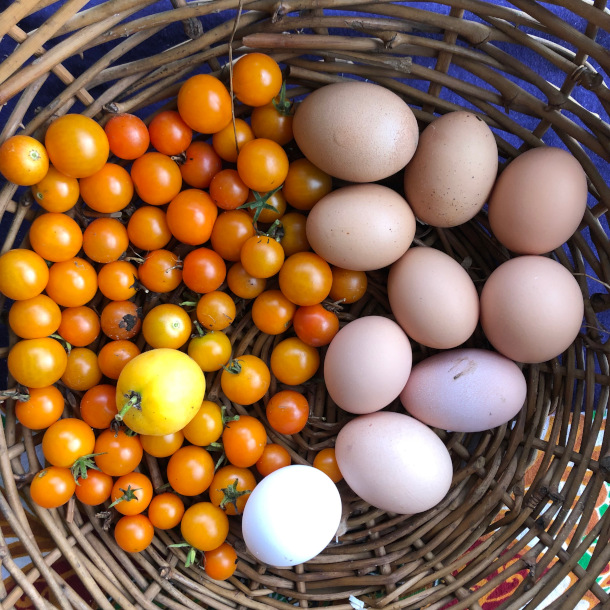
Tomatoes and eggs from Bobby Bascomb’s garden. (Photo: Courtesy of Bobby Bascomb)
McCLELLAN: Yeah, or leave it even longer and you'll have vinegar, perfect. Oh, I hadn't thought about that. Yeah, and if you have a bottle of store-bought vinegar that has a little bit of that mother on it, you know the culture that forms that little scum on the surface, you can pluck that out and put it into your apple juice, and it'll jumpstart the vinegar process, and it'll be even faster and better.
BASCOMB: Oh, wow. Now I've read that you can actually take the pulp that's left from making cider and use that to make apple cider vinegar. I haven't tried it yet, though.
McCLELLAN: Hmm, I guess you could do that. You could combine that with water and then yeah, that would work, definitely. You could also take that pulp and combine it with a little bit of sugar and cook it into sort of a paste. And then you'd have like an apple cheese, which is an old school fruit preservation method. Like you know how you get quince paste, it would be an apple paste like that.
BASCOMB: Apple, did you say cheese?
McCLELLAN: Yeah, that's the name for those fruit preserves that are cooked to the point where it's like a sliceable paste. It's often called the fruit cheese.
BASCOMB: Oh, I had no idea. No, idea. All right. Okay, well, you've given me a lot of ideas here. You know where I live, we still haven't had a frost. So I'm actually harvesting loads of tomatoes yet they're not looking so great I have to say, the vines, but the tomatoes are still producing. What do you like to do with those this time of year?
McCLELLAN: Tomatoes are my favorite thing to preserve this time of year and they are the gift that just keeps giving. I love to sauce them just you know, pulp them cook them down into sauce, and can that with a little bit of lemon juice or citric acid, you know that's you can never go wrong. I also make pizza sauce this time of year, which is really great one to have in the pantry. And I love to make tomato jam, that's another one that that's actually the most popular recipe I've ever published on my website. People have come back to me for years saying that that became their beloved family recipe too. And it's really just tomatoes and sugar and lime juice and a bunch of spices and you cook it down and it turns into something that is like ketchup, but is better than any ketchup you've ever had and it can go places that ketchup can't. So that's a really good one for your tomatoes. And it's great because you don't have to peel them like that's the beauty of that recipe is that you want the skins in it because it gives a texture.
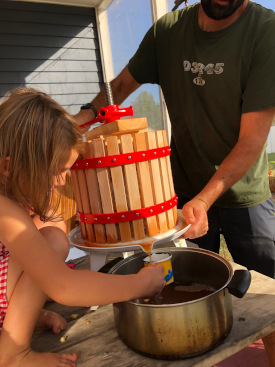
A cider press is a great way to crush apples and pears and create a delicious cider beverage. (Photo: Courtesy of Bobby Bascomb)
BASCOMB: What about roasting tomatoes or you know, even sun-dried tomatoes?
McCLELLAN: That is also a great way to go. I love to roast tomatoes low and slow. So you cut them in half, put them in a really low oven for like 10 to 14 hours and they kind of dry out. It becomes almost sun roasted and then it's just like this concentrated tomato nugget. And then you can either freeze them or you can puree them into sauces and you know, proceed with canning them that way, but they are delicious.
BASCOMB: Could you even put it in a jar with olive oil and garlic, that sort of thing and hold on to it until you need it?
McCLELLAN: That is actually not a great technique because it can cultivate botulism. So botulism is the thing we're scared of when it comes to canning. And tomatoes are not actually as acidic as we think they are and so if you need to have a high acid preserve, you need to often add acid to tomatoes to make them safe. And then if you add garlic, which is a low acid food to a tomato, and then you create an anaerobic environment with that olive oil, it can create something that's potentially deadly. So it's better if you're going to add garlic that you keep lots of oil out of it and then either freeze it or refrigerate it as opposed to canning it because you just want to be safe.
BASCOMB: No one wants botulism.
McCLELLAN: Nobody, nobody wants it.
BASCOMB: No indeed. What about green tomatoes?
McCLELLAN: Green tomatoes are fabulous and I know everybody has them who gardens this time of year. I love to turn them into chutney and chutney is such an easy preserve to make. There's no technique, there's no set point you're looking for you chop up the tomatoes, you put them in a pot with sugar, vinegar, onion, maybe some raisins or other dried fruit and spices and you just boil it down. You just keep cooking it until it's thick. Like that's it and you can do it slower and it'll take like two or three hours you could do a little bit faster if you have to monitor it, and it'll take maybe 90 minutes and then once it's thick once it's not looking at all watery, it's done. And you can water bath can it as long as you're following a recipe that was created with that acid balance in mind, or you can just put in the refrigerator and eat it up. But it's great particularly if you're planning ahead for the holidays, because it's great on a cheese board, it's great with the roasted turkey and roasted meats that we see a lot of times as we head into the holidays. It's also even great with latkes so it's a really good one for this time of year.
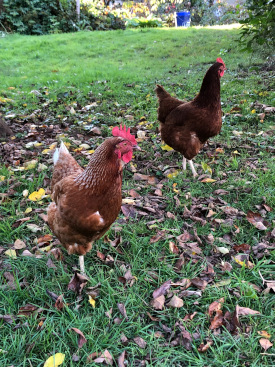
Apart from producing fresh eggs and acting as pest control, chickens are excellent at scratching through fall leaves and cutting them into pieces so they’re better absorbed by soil. (Photo: Courtesy of Bobby Bascomb)
BASCOMB: What about pickling produce? I know pickles aren't exclusive to cucumbers. What else do you like to pickle?
McCLELLAN: Well this time of year I love to pickle the last zucchinis they make a great pickle. Just you treat him like a cucumber, slice them up, and I like to make them as refrigerator pickles. I also love to do carrots this time of year you know just make carrot coins or carrot spears and do them in the same kind of dilled and garlic brine that I would do cucumbers in. Even the brussel sprouts is a really good candidate for pickling this time of year and they are better I find if you do them fresh because if you don't process them in a boiling water bath canner because then they're crispy and you don't get that kind of signature cabbage cooked cabbage stink that you would get. And so those are great cauliflower another one cauliflower makes a really great pickle. I like to do with a lot of lemon juice because that helps prevent the cauliflower from turning gray in the jar and cauliflower can turn a little gray, but the lemon juice helps keep it nice and bright and white.
BASCOMB: Well pretty soon of course Halloween will be here. Is there anything that we can do with those leftover jack o' lanterns when the holiday is past, I know they're not the best pumpkin for cooking usually because they're so big and a little bit more watery. They're not as sweet as we usually like pumpkins to be. But what can we do with them besides just throw them in the compost?
McCLELLAN: Well, if you've already carved it and it's been out for a few days, it might not be great to cook down but if it's still in good shape or you've got a pumpkin you were just using for decor and it wasn't carved up. Here's what I would do I would take it and I would roast it. You can either roasted whole if it's still intact or if you've got a jack o' lantern where you carved it that night and it's just out for Halloween and then you bring it back in. You can cut it up into pieces and roast it and then you know 300- or 350-degrees Fahrenheit roasted just till it's tender, then you scrape the flesh out of the skin. I also like to put those seeds aside and you can grab the seeds even if you've roasted the pumpkin and scoop them out separate the seeds from the stringy mess and then what I like to do with the seeds is boil them in some salted water then drain them and then roast them and by doing that you get the salt infuses the seeds and just makes them more flavorful. But then once you've got the pumpkin flesh you scrape it out of the skin and what I like to do is puree it and then drain it. So because those big pumpkins for Halloween those big jack o' lanterns can be very watery. And so you want to concentrate the flavor of the flesh and so you've already kind of concentrated the sweetness by roasting it and then you scrape it out and puree it in a blender or use an immersion blender and kind of zap it and then put it in a fine sieve and let the water drain out. And if you don't have a fine sieve you can line a colander with cheesecloth or even just a clean then kitchen towel and let the water drain out. And then what you have left is a very concentrated hopefully fairly thick pumpkin puree that you can pack into containers and freeze and then use in like pumpkin bread. You could use it as sort of like a pumpkin souffle. I also like to take those containers I tend to freeze it in two cup portions and stir it into risotto into the fall and winter that's delicious because you've got that kind of creamy rice you stir in the pumpkin it makes it really rich. So that's great. You can also cook it down into pumpkin butter which is delicious. I like to combine it with maple sugar and spices and a little bit of lemon juice and cook it down and cook it down. And then that's something that I keep in the fridge or I freeze. Pumpkin butter is too low in acid to be canned safely but it's still delicious just to have on hand.

Marisa McClellan is a food writer and creator of Food in Jars. (Photo: Courtesy of Marisa McClellan)
BASCOMB: And of course, pumpkin pie.
McCLELLAN: And of course, pumpkin pies. I feel like that, you know it's so obvious it goes without saying.
BASCOMB: Of course. Marisa McClellan is a cookbook author, a food writer and creator of Food in Jars. Marisa, thank you so much for taking this time with me today.
McCLELLAN: Thank you. It's really been a pleasure.
CURWOOD: Thanks, Bobby. Now I have some great ideas for what to do with all those pumpkins in front of my house.
BASCOMB: Yeah, me too. You know, I’m really not a fan of green tomatoes but I may have to try green tomato chutney.
CURWOOD: That sounds good, you cook, I’ll taste.
BASCOMB: Ok, as long as you clean up after!
Related links:
- Learn more about Marisa McClellan and check out her recipes
- Learn how to make apple paste, a.k.a. apple-quince fruit cheese
- Learn how to make a classic tomato jam sweetened with honey
- Learn how to make green tomato chutney
[MUSIC: Chet Baker, “Autumn Leaves” on Jazz Moods – Cool, Sony BGM Music Entertainment]
CURWOOD: Living on Earth is produced by the World Media Foundation. Our crew includes Naomi Arenberg, Paloma Beltran, Jenni Doering, Jay Feinstein, Mark Seth Lender, Don Lyman, Aynsley O’Neill, Jake Rego, Genevieve Santilli, Teresa Shi, Gabriell Urton, and Jolanda Omari.
BASCOMB: Tom Tiger engineered our show. Alison Lirish Dean composed our themes. You can hear us anytime at L-O-E dot org, Apple Podcasts and Google Podcasts, and like us, please, on our Facebook page - Living on Earth. We tweet from @livingonearth. And find us on Instagram at livingonearthradio. I’m Bobby Bascomb
CURWOOD: And I’m Steve Curwood. Thanks for listening!
ANNOUNCER: Funding for Living on Earth comes from you, our listeners, and from the University of Massachusetts, Boston, in association with its School for the Environment, developing the next generation of environmental leaders. And from the Grantham Foundation for the protection of the environment, supporting strategic communications and collaboration in solving the world’s most pressing environmental problems.
ANNOUNCER 2: PRX.
Living on Earth wants to hear from you!
Living on Earth
62 Calef Highway, Suite 212
Lee, NH 03861
Telephone: 617-287-4121
E-mail: comments@loe.org
Newsletter [Click here]
Donate to Living on Earth!
Living on Earth is an independent media program and relies entirely on contributions from listeners and institutions supporting public service. Please donate now to preserve an independent environmental voice.
NewsletterLiving on Earth offers a weekly delivery of the show's rundown to your mailbox. Sign up for our newsletter today!
 Sailors For The Sea: Be the change you want to sea.
Sailors For The Sea: Be the change you want to sea.
 The Grantham Foundation for the Protection of the Environment: Committed to protecting and improving the health of the global environment.
The Grantham Foundation for the Protection of the Environment: Committed to protecting and improving the health of the global environment.
 Contribute to Living on Earth and receive, as our gift to you, an archival print of one of Mark Seth Lender's extraordinary wildlife photographs. Follow the link to see Mark's current collection of photographs.
Contribute to Living on Earth and receive, as our gift to you, an archival print of one of Mark Seth Lender's extraordinary wildlife photographs. Follow the link to see Mark's current collection of photographs.
 Buy a signed copy of Mark Seth Lender's book Smeagull the Seagull & support Living on Earth
Buy a signed copy of Mark Seth Lender's book Smeagull the Seagull & support Living on Earth

